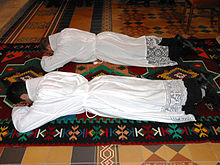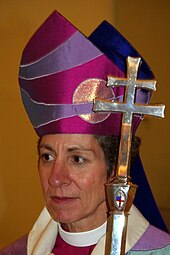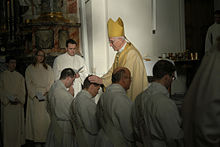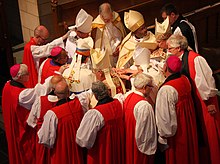Sacrament of Orders
The sacrament of consecration or sacrament of ordination ( Latin ordinatio , "inclusion in the respective ordo "), also sacrament of the laying on of hands , is in many Christian denominations a sacrament through which the consecrated person receives a mission and authority in the name of Christ for the church to act.
The ordination comprises three ordered stages: the diaconate (deacon ordination), the presbyterate (priestly ordination) and the episcopate (episcopal ordination), whereby the fullness of the sacrament is united only in the latter as the highest ordination level. Reception of consecration leads to admission into the clergy and incardination into a diocese or religious community .
Emergence
Like all sacraments, the sacrament of Orders goes back directly to an institution by Jesus Christ handed down in the New Testament and the tradition of the Church . While in his sermons Christ called the entire people of Israel to follow him ( priesthood of all believers ), he called the twelve apostles into a special discipleship and entrusted them to lead the Church. Through the Holy Spirit ( Acts 1,8 EU ) he has given them authority and mission to act in his place and to serve him as a living instrument:
The consecration goes beyond a delegation by the community, because they
"Bestows a gift of the Holy Spirit that allows a" sacred power " ( sacra potestas ) to be exercised that can only be bestowed by Christ himself through his Church."
By working in persona Christi it is guaranteed that Christ himself is active in the sacraments to mediate salvation , regardless of the virtues or faults of the minister.
“Christ is the source of all priesthood; for the priest of the law was his image. But the priest of the new covenant acts in the person of Christ "
The dispensing of the sacraments is of particular importance, in particular the celebration of the Eucharist , which Jesus instructed the apostles to do with the words “Do this in memory of me!” ( Lk 22:19 EU ).
Already from apostolic times the laying on of hands is handed down as a sign of the passing on of this calling ( Heb. 5,4 EU ) , combined with the consecration prayer to invoke the Holy Spirit ( Acts 6,6 EU , Acts 14,23 EU , Acts 20,28 EU ); the candidates were selected by the apostles ( Acts 1.23–26 EU ) and their chosen successors. They preached the gospel and took over the leadership of the congregations in continuation of the priestly mission.
Understanding of the sacrament
There is the sacrament of consecration in the churches of the Catholic and Orthodox tradition, in particular the Roman Catholic Church , the Orthodox , Old Oriental , Old Catholic and Anglican churches , as well as other, according to their own self-image, Catholic churches. It is donated by Christ through a bishop . Due to the common origin of the Sacrament of Orders in the early Church and the resulting Apostolic Succession , the orders are mutually recognized by many denominations .
In almost all of these churches, consecration is considered a sacrament ( sacramentum ordinis ) , and in some Anglican churches it is considered a sacramental .
Validity of consecration
An ordination is valid and has been performed as a sacrament if all the necessary prerequisites are met: The donating bishop, standing in apostolic succession, must be endowed by Christ with the mandate to donate the sacrament. The recipient must be baptized and male, but some churches also view the ordination of a woman as valid. The recipient must also be called and qualified to serve in this office by the Church.
Independent of the validity of the ordination, the question of its legality is. In the Roman Catholic Church a bishop's consecration should allowed only on behalf of the Pope done. Even without this one ordination is still considered sacramentally valid , however, is prohibited and will to can. 1382 CIC "Presumption of office and violation of official duty" results in excommunication as a criminal offense .
Ordination of women
An essential difference in the understanding of the sacrament in the various churches lies in the permissibility of the ordination of women. According to Catholic doctrine, the sacrament of consecration can only be validly received by a man. This is represented by the Roman Catholic Church, the Orthodox and Old Oriental Churches, as well as some Anglican and Old Catholic Churches.
Most Old Catholic and Anglican churches also consider the ordination of women to be valid. However, it is partially limited to the diaconate or the presbyterate. Even if there is otherwise a mutual recognition of ordinations in principle, ordinations with the participation of a woman as donor or recipient are regarded by the other churches as invalid and without sacramental effect.
The fundamental restriction of admission to the sacrament of ordination is justified by the fact that Jesus only called men to be his apostles when he instituted the sacrament ( Mk 3,13–19 EU , Lk 6,12–16 EU ). The Church is bound by this divine determination and therefore has no authority to bestow this sacrament on a woman. This is not seen as discrimination , but as an appreciation of the natural diversity of the sexes.
“When Christ called only men to be his apostles, he did so freely and independently. He did it with the same freedom with which he emphasized the dignity and vocation of women in his overall behavior, without complying with the prevailing customs and the tradition approved by the legislation of the time "
The apostles also called exclusively men to be their successors ( 1 Tim 3,1-13 EU , Tit 1,5-9 EU ). This practice is already documented from the early church and is therefore also seen as part of the church tradition.
Another reason is that a priest does not act in person when exercising the powers obtained through ordination, but in persona Christi ("in the place of Christ"), which is why a natural similarity ( naturalis similitudo ) is necessary or at least required was to make the embodiment of the man Jesus recognizable.
“So that any doubt about the important matter concerning the divine constitution of the Church itself is removed, I declare by virtue of my office to strengthen the brothers ( Lk 22:32 EU ) that the Church has no authority to ordain women to priests to donate, and that all believers of the Church must finally adhere to this decision "
Giving of consecration
The central, externally visible act of the consecration is the laying on of hands and the consecration prayer of the donor. The tradition of the laying on of hands has been documented since the early Church and can already be found in the letters of the New Testament ( 2 Tim 1,6 EU ).
Since the sacrament of consecration gives the soul a character indelebilis (indelible mark), a validly received sacrament of consecration is irrevocable and its administration is never repeated. In case of doubt, however , the ordination rite can be repeated sub conditione if the validity of an ordination that has taken place is questionable. Even with fundamental mutual recognition of the sacrament of ordination , this occurs again and again in the conversion of clergy if the sacramentality of the ordination carried out in the other denomination is doubted (for example due to an unclear ordinance line with regard to apostolic succession).
The ordination remains unaffected by the loss of the clerical status : "Once validly received, holy ordination is never invalid". However, the “invalidity of the holy ordination” can be established by judicial judgment or administrative decree if it was not validly received. However, this is only a formal statement; in such a case, the ordination never existed.
Minor ordinations
The minor orders are not sacraments, but rather correspond to a liturgical commission. In 1973 they were largely abolished in the Roman Catholic Church with the Motu proprio Ministeria quaedam . In the Latin Church they are only preserved in the extraordinary form .
In the Orthodox Churches and the Eastern Catholic Churches of the Byzantine rite they continue to exist as preliminary stages to the higher sacramental orders .
Stages of consecration (degrees of consecration)
The one sacrament of consecration unfolds in three stages ( ordines ):
- Diaconate (deacon ordination, ordo diaconorum , ordinatio diaconorum ) - the main tasks of the deacon are in the diaconal and pastoral service, the proclamation of the Gospel and the celebration of divine service .
- Presbyterate (ordination, ordo presbyterorum , ordinatio presbyterorum ) - the priest , as an employee of the bishop, takes on the management of parishes and the dispensing of the sacraments (with the exception of ordination).
- Episcopate (episcopal ordination, ordo episcoporum , ordinatio episcopalis ) - the bishops , as successors to the apostles, are responsible for the leadership of the church. The fullness of the sacrament of consecration is united in the third and highest level of consecration.
The individual stages build on one another: to receive the ordination, the deacon ordination is required, for the episcopal ordination the priestly ordination. The episcopal and priestly ordination confer the mission and the authority to act in the person of Christ , the deacon ordination "on the other hand the power to serve the people of God in the diakonia of the liturgy , the word and love" ( can. 1009 §3 CIC ).
Through ordination, the candidate is accepted into the respective ordo of the church (Ordo episcoporum, Ordo presbyterorum and Ordo diaconorum) .
Diaconate

The offering of the sacrament takes place through the laying on of hands and consecration prayer by the bishop. Through this, the ordination candidates are requested to be given the gift of the Holy Spirit for the office of deacon. Finally, the dressing up with the insignia of the deacon, stole and dalmatic , as well as the delivery of the gospel .
The public and voluntary promise of consecration of the respective candidate, which is made during the ordination rite, is viewed as a legally binding act .
Presbytery

Ordination to the priesthood enables the sacraments to be administered, with the exception of the sacrament of consecration, and is therefore at the same time an ability and a mandate for special, sacramental and pastoral service to the Church. It is a prerequisite for access to most church offices , such as the appointment of a pastor .
"Ordination is not donated as a remedy for a single person, but for the whole Church"
The central act of priestly ordination is the laying on of hands and the consecration prayer of the donating bishop. The laying on of hands is then carried out by all the bishops and priests present who bless the new priest. This is followed by the anointing of the hands with chrism , the putting on of the chasuble and the presentation of the chalice and host bowl as interpretative rites .
Before ordination, a candidate for the priesthood usually goes through several years of training, including studying theology in a seminary , a seminary belonging to the order, a theological convict , a spiritual academy or similar institution.
Episcopate
The episcopal ordination represents the full form of the sacrament of ordination; the other two levels are derived from it.
An ordained bishop is in his office in the direct, unbroken succession of the apostles . The consecration lines of the bishops are traced back in apostolic succession to the apostles, who were installed in the office of bishop by Jesus Christ .
The central act here is the laying on of hands by the bishop giving the consecration (main consecrator) and the other bishops present (co-consecrators) as well as the consecration prayer. To ensure the validity of the ordination in apostolic succession, at least two co-consecrators are usually called in; Should the sacramental validity of the ordination of one of the donating bishops themselves be questionable, the ordination through the work of the co-consecrators is to be considered valid.
The act of consecration begins with a request for the Holy Spirit so that the person to be consecrated, as shepherd, “cares for the church of God, which he has acquired through the blood of his own Son” ( Acts 20:28 EU ). The candidate then promises to be faithful to the faith and to administer his office properly.
As a sign of the full share in the priesthood of Christ, the forehead of the new bishop is anointed with holy chrism . The handing over of the gospel and the episcopal insignia ( bishop's staff , ring and miter ) symbolizes the main tasks of the bishop: the preaching of the gospel and the leadership of his local church .
"Through episcopal ordination themselves, with the ministry of sanctification, the bishops also receive the ministries of teaching and guiding, which by their nature they can exercise only in hierarchical communion with the head and members of the college."
Ordination rite
The ordination is always given by a bishop and in the context of a pontifical ministry . According to Cann. 1010 and 1011 of the Codex iuris canonici , ordination should generally take place on a Sunday or other required public holiday and be celebrated in the cathedral church . However, deviations from this are possible for pastoral reasons.
Deacon ordination
The liturgy for the ordination of deacons begins after the proclamation of the Gospel . The ordination candidates solemnly declare their readiness for ordination before the bishop and promise him their obedience. This declaration includes the obligation to serve the good of God's people , to proclaim God's word in word and deed, to live celibacy (if not married), to help those in need and to live according to the example of Christ.
These are in detail:
- Willingness to be ordained to serve the Church
- To exercise the ministry of the deacon with selfless dedication in support of the bishop and priests and for the good of the Christian people
- To guard the treasure of faith and to proclaim it in word and deed according to the gospel and tradition of the Church
- (for non-married candidates :) celibacy for the sake of the kingdom of heaven, to remain true to this resolution and to serve God and people in this way of life
- Willingness to live from the spirit of inwardness, to become a man of prayer and to perform the Divine Office faithfully
- To help the poor and the sick, the homeless and the needy
- To shape one's own life according to the example of Christ
- Reverence and obedience to the bishop and his successors
- (in the case of married candidates by the wife :) Support of the deacon in his service
Ordination
After the Kyrie , the candidates are called by name. The bishop's sermon is followed by promises of obedience and the calling down of the Holy Spirit in the All Saints litany .
The public and voluntary promise of consecration of the respective candidate, which is made during the ordination rite, is viewed as a legally binding act .
These are in detail:
- Willingness to exercise the priesthood as a reliable co-worker of the bishop and thus prudently lead the community under the guidance of the Holy Spirit
- To fulfill the service of the word of God (proclamation of the Gospel and exposition of the Catholic faith) faithfully and conscientiously
- To celebrate the sacraments according to Church tradition
- To implore God's mercy for the community in prayer with the bishop
- To help the poor and the sick, the homeless and the needy
- To connect more closely with Christ every day (here the answer is “With God's help I am ready” instead of “I am ready”)
- Reverence and obedience to the bishop and his successors
Episcopal ordination
The consecration ceremony in the older liturgical language consecration called, is usually in a holy mass embedded and joins the Liturgy of the Word on. The consecration is followed by the celebration of the Eucharist ; Holy Mass closes with the solemn blessing of the newly ordained bishop.
The public and voluntary promise of consecration of the consecration candidates, which is made during the ordination rite, is regarded as a legally binding act . Its individual components are readiness
- to serve in the episcopate until death
- to preach the gospel faithfully and tirelessly
- to pass on the faith inherited by the apostles to the Church in pure and unabridged form;
- to participate in the construction of the church and the unity with the college of bishops and the church
- for faithful obedience to the Pope (for Roman Catholic bishops)
- for fatherly care for the people of God , together with the priests and deacons
- for kind encounter and mercy towards the poor, homeless and needy
- to pursue the lost as a good shepherd and to lead them back to the flock of Christ
- to pray for the salvation of God's people and to exercise the office of high priest
Traditions of the Churches
Despite fundamental similarities in the understanding of the sacrament, different traditions have developed in the various churches with regard to its implementation and handling. The main differences are in the admission of women to the ordination office and the requirement of the promise of celibacy.
Roman Catholic Church
The Roman Catholic Church consists of the Western, Latin Church and the Eastern Catholic Churches , which are in the tradition of the Eastern Orthodox and ancient Eastern Churches.
Latin Church
In the Latin Church there is a fundamental obligation of celibacy for all clerics . However, already married candidates for ordination may be ordained deacons. This is regularly the case with so-called permanent deacons , in rare exceptional cases with papal dispensation also with priests, which is sometimes allowed for married clergymen of other Christian denominations who have converted to Catholicism . These deacons and priests are generally not allowed to remarry after their wife's death.
Permanent diaconate
The Second Vatican Council restored the office of permanent diaconate for the Roman Catholic Church in the dogmatic constitution on the Church Lumen Gentium . Since then, married men have been re-admitted to the office of deacon when they are at least 35 years old. However, marriage after consecration is not permitted, including after the death of the wife.
Eastern Catholic Churches
In the majority of the Eastern Catholic Churches, priests and deacons in the Eastern regions are not obliged to be celibate. Therefore, already married candidates for the priesthood have always been able to receive ordination there under the old law. In June 2014, Pope Francis extended this right of uniate Eastern Church bishops to the priestly ordination of married men to western areas, as far as there is a separate Eastern Church hierarchy there. Where there are Eastern Church Ordinariats in western areas but no competent Eastern Church bishops, the competent Roman Catholic bishop now has the power to ordain married candidates for the priesthood for the first time.
Orthodox churches
In addition to the three levels of consecration, Orthodoxy, especially the churches of the Byzantine rite , also knows the minor and monastic consecrations . There is no obligation to be celibate for priests and deacons . Since the bishops have to be unmarried, they mostly come from the monastic class .
Old Catholic Church
In the Old Catholic Church , the bishop is responsible for the leadership of the local church , the priestess and the priest the leadership of the sub-community ( parish ) or other tasks in leadership and teaching, and the deacon is responsible for the social or administrative service of the sub-community or the diocese, as well as helping in liturgy and proclamation . The three forms of ordination do not represent superiority and subordination , but complementary functional aspects of one and the same sacrament. The Old Catholic Church knows ordination to the office of deacons , priests and bishops ; there is no celibacy obligation . The involvement of the ecclesiastical office in synodal bodies is essential and typical of the Old Catholic Church, which is why a bishop is always elected by a synod and a pastor is elected by a parish assembly. Women have been ordained deacons in the German diocese since 1988, and in 1994 the diocese synod approved the equal admission of men and women to all ordained offices.
literature
- Catechism of the Catholic Church . Oldenbourg, Munich / Vienna / St. Benno, Leipzig / Paulus, Friborg / Veritas, Linz, 1993, ISBN 3-486-55999-0 , 2nd part, 2nd section, 3rd chapter: The sacraments of service for the community . Article 6: The Sacrament of Consecration (1536) - ( vatican.va ).
- German Bishops' Conference (Ed.): Catholic Adult Catechism : The Church's Confession of Faith . 3. Edition. Butzon & Bercker, Kevalar / Don Bosco, Munich / Katholisches Bibelwerk, Stuttgart / Lahn, Limburg / Pfeiffer, Munich / Puset, Regensburg / Styria, Cologne, 1985, ISBN 3-7666-9388-3 , 3rd part, 4th chapter : 6. The Sacrament of Consecration , p. 380 ff .
- Andrej Lorgus, Michael Dudko: Orthodox Faith Book: Introduction to the Faith and Prayer Life of the Russian Orthodox Church . 2nd Edition. Christian East, 2002, ISBN 3-927894-33-8 , chap. 5: Sacraments and rites: The sacrament of ordination ( online version at Orthpedia - Russian: Книга о Церкви . Translated by Viktor Schilovsky, Johann Krammer).
Web links
- Herbert Frohnhofen: § 9. Ordination. current literature on the Sacrament of Orders. In: Theology-Systematic: Sacraments. Retrieved March 17, 2013 .
Individual evidence
- ^ The Catechism. An Outline of the Faith, commonly called the Catechism. Section The sacraments . April 15, 2007, accessed June 29, 2011 .
- ↑ a b can. 1024 CIC "Candidates"
- ↑ Congregation for the Doctrine of the Faith (Ed.): Inter insigniores : “Declaration on the question of the admission of women to the priesthood” . Vatican 1976 ( vatican.va ).
- ^ Pope John Paul II: Mulieris dignitatem . Apostolic Exhortation “On the Dignity and Vocation of Women” . Vatican 1988 ( vatican.va ).
- ^ Clement of Rome : First Clement's letter . Rome, Chapter 44 The apostles tried to prevent controversy by appointing bishops. ( unifr.ch - around 100 AD).
- ^ Pope John Paul II: Ordinatio sacerdotalis . Apostolic Exhortation “On ordination reserved for men only” . Vatican 1994 ( vatican.va ).
- ↑ a b can. 290 CIC "Loss of Clerical Status"
- ↑ can. 1009 §1 CIC "Consecration"
- ↑ Catechism of the Catholic Church : [1536] Article 6: The Sacrament of Consecration
- ↑ can. 521 §1 CIC "Parishes, Pastors and Parish Vicars"
- ↑ can. 1014 CIC "Consecration Celebration and Consecration Donor"
- ↑ Catholic priests - without celibacy. In: Christ in der Gegenwart , No. 47/2014, p. 526.
- ↑ a b c Ordination, Sacrament of Orders. Retrieved July 1, 2015 .
- ↑ Women's ordination. Retrieved December 4, 2018 .








